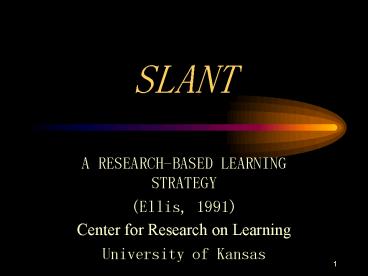SLANT - PowerPoint PPT Presentation
1 / 10
Title:
SLANT
Description:
SLANT A RESEARCH-BASED LEARNING STRATEGY (Ellis, 1991) Center for Research on Learning University of Kansas * WHAT IS A STRATEGY? A STRATEGY a person's approach to ... – PowerPoint PPT presentation
Number of Views:540
Avg rating:3.0/5.0
Title: SLANT
1
SLANT
- A RESEARCH-BASED LEARNING STRATEGY
- (Ellis, 1991)
- Center for Research on Learning
- University of Kansas
2
WHAT IS A STRATEGY?
- A STRATEGY a person's approach to learning and
using information. - It is an approach for students on how to think
about and solve problems, or how to learn - Learning strategies are used by students to help
them understand information.
3
What is the SLANT Strategy?
- Helps you to participate in class in appropriate
and productive ways - Steps cue you to combine nonverbal (bodily),
thinking skills, and verbal behaviors to activate
your participation in class effectively - Students who master SLANT understand why it is
important to actively participate during class
and how to do so.
4
What will this help me to do in the classroom?
- Understand what information is important to
learn, and why learning it is important - How to study effectively for a test
- Helps you to create new ways to organize and
categorize information over time - Helps build comprehension skills, connections,
and questioning skills - Helps learning becoming more personal, fun, and
interesting - Improves the quality of your participation and
memory of material - What else might this strategy help you with?
5
S is for SIT UP
- Example
- Upright posture but relaxed
- Non Examples
- Head on desk
- Slouching in chair
6
L is for LEAN FORWARD
- Example
- Leaning forward slightly
- Non Examples
- Leaning backward
- Exaggerated forward lean
7
A is for ACTIVATE YOUR THINKING
- Examples
- Asking yourself questions
- Answering your questions
- Asking the teacher a question you dont
understand - Make connections to self, text, world
- Non Examples
- Talking to others during class
- Playing with objects
- Doodling
- Doing nothing when you dont understand
8
N is for NAME KEY INFORMATION
- Examples
- Answering the teachers questions
- Sharing your ideas or comments
- Adding to others statements
- Non Examples
- Keeping knowledge to yourself when you
could help others - Ridiculing other students comments
9
T is for TRACK THE TALKER
- Examples
- Keeping eyes on teacher when she/he speaks
- Looking at students when they speak
- Non Examples
- Staring out the window
- Looking at your desk or students who are
not contributing
10
Positive Participation Makes a Positive
Difference!!































